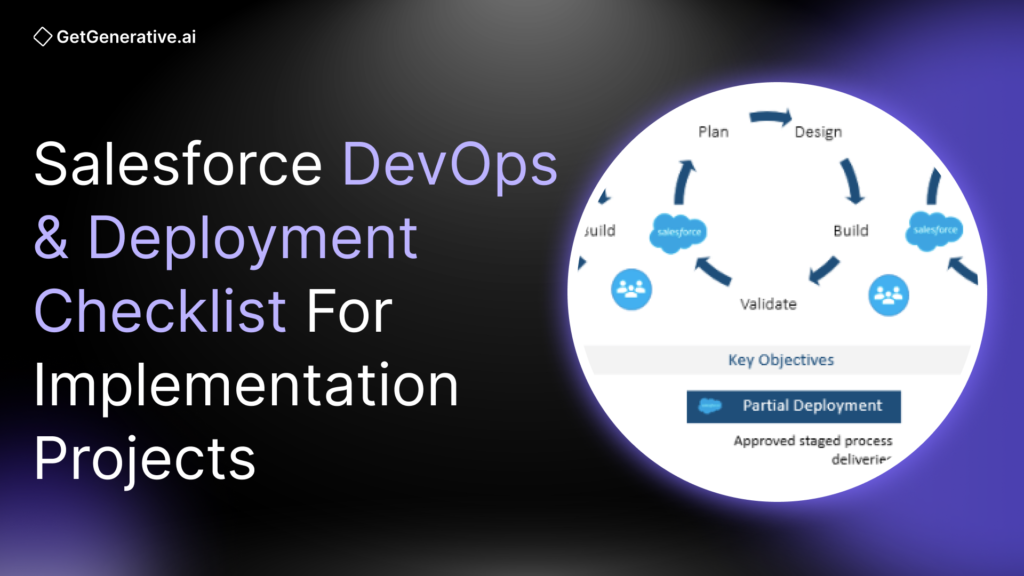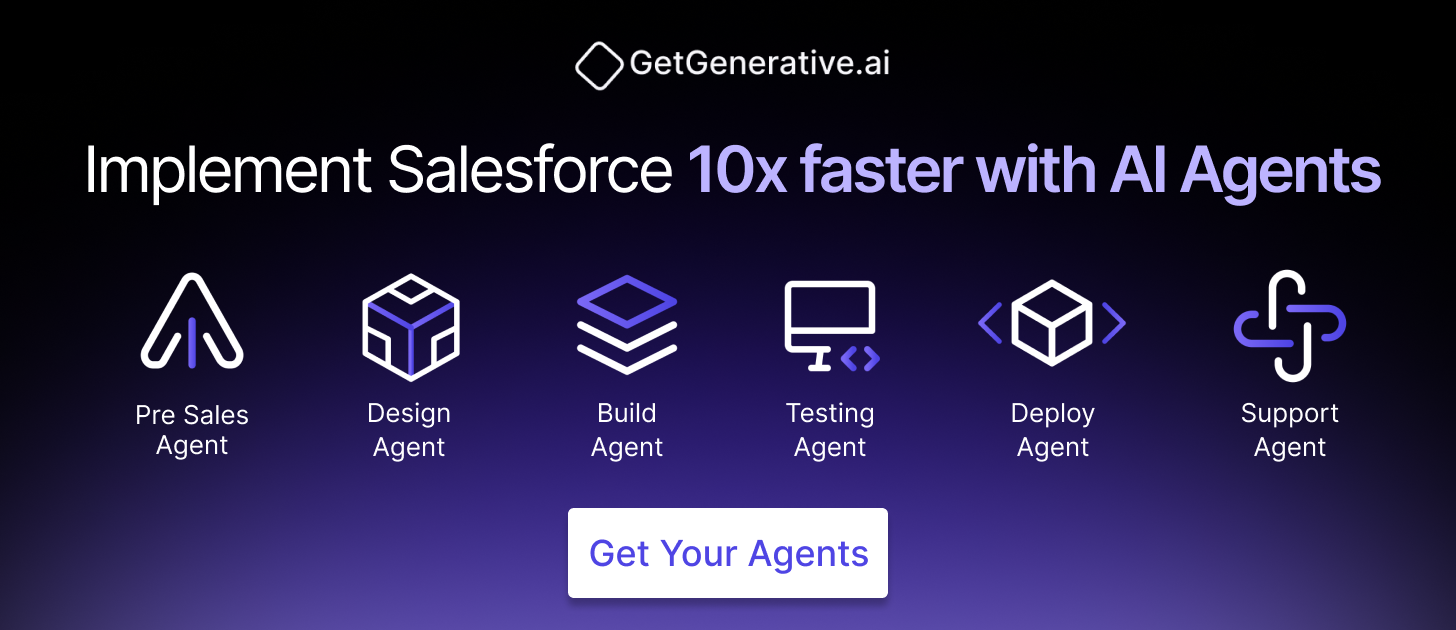Salesforce DevOps & Deployment Checklist for Implementation Projects
Even the most experienced Salesforce teams understand the stress of a high-stakes deployment. In enterprise environments, a failed Salesforce release can disrupt mission-critical operations and damage stakeholder trust. According to Salesforce, 62% of IT leaders struggle to balance business demands with operational efficiency.
That’s where Salesforce DevOps comes in—not just as a buzzword, but as a strategic framework for faster, safer, and more reliable software delivery. When done right, DevOps practices can improve release velocity, reduce failure rates, and enhance collaboration across admin and development teams.
For example, some organizations have achieved up to 500% ROI by adopting DevOps practices or have reduced deployment times from days to minutes.
This guide outlines advanced Salesforce DevOps strategies, tailored for implementation at scale. Whether you’re a Salesforce architect, DevOps lead, or a CXO overseeing digital transformation, you’ll find actionable insights, industry benchmarks, and a complete deployment checklist to ensure project success.
Let’s get started!
Why DevOps is Critical in Salesforce Implementation Projects
Salesforce DevOps goes beyond agile buzzwords—it’s essential infrastructure for scalable, secure, and rapid innovation. Key reasons why:
- Faster, safer releases: DevOps practices like CI/CD and automated testing enable frequent, low-risk deployments.
- Better business alignment: IT teams can respond to fast-changing business needs without sacrificing quality.
- Real ROI: High-performing DevOps teams deploy 60% more often, experience 10% fewer failures, and recover 65% faster than peers.
DevOps provides the coordination layer in enterprise-scale Salesforce rollouts, where dozens of teams work on configurations, code, integrations, and data migrations. It ensures that all contributors—from admins to Apex developers—work off a shared source of truth with version control, automated builds, and standardized testing.
Unique Challenges in Enterprise Salesforce Deployments
Salesforce deployments differ significantly from traditional software rollouts. Key challenges include:
1. Metadata Complexity
Salesforce metadata is vast and interdependent—changes to profiles or flows can trigger cascading issues. For example, one city government reported 8-hour-long deployments due to manual dependency checks.
2. Environment Drift
Large orgs often manage multiple sandboxes (Dev, QA, UAT, etc.). Without automation, configurations can drift, causing major rework. Veolia, operating with 65+ sandboxes, found their environments “completely out of sync” before adopting DevOps.
3. Siloed Teams
Admins often use UI-based deployment methods, while developers use CI scripts. This mismatch results in bottlenecks and missed dependencies. Today, 73% of teams use unified pipelines for both declarative and programmatic changes.
4. High-Stakes Compliance
Failed deployments can risk compliance with regulations like SOX or GDPR. One real estate firm, Cushman & Wakefield, cut SOX audit prep time by 50% by adopting a Salesforce-native DevOps platform
5. Outdated Tools
Manual change sets don’t scale. Denver’s Salesforce team needed two people and eight hours per deployment—until they switched to an automated DevOps solution.
Also Read – Salesforce Test Plan Template & UAT Checklist
Advanced Salesforce DevOps Strategies
1. Version Control as the Source of Truth
Everything—code, config, metadata—should live in Git. This enables traceability, concurrent development, and robust audit trails. 86% of Salesforce teams have adopted or plan to adopt Git-based workflows.
- Use Salesforce DX for metadata retrieval
- Organize repositories with unlocked packages for modularity
- Track changes via Git commit messages linked to work items
2. CI/CD Pipelines
81% of Salesforce teams have implemented CI/CD or plan to. CI/CD involves:
- Triggering deployments on Git commits
- Running Apex tests and static analysis tools
- Promoting validated builds from lower to higher orgs (Dev → QA → UAT → Prod)
Companies like Intercom now ship 3–4 Salesforce updates per day with no dedicated release manager.
3. Use Agile and Iterative Delivery
In large Salesforce implementation projects, agile methods reduce risk and increase responsiveness. Rather than “big bang” deployments, aim for incremental releases aligned to sprints.
- Break work into smaller deliverables
- Push features to test environments or pilot groups regularly
- Gather user feedback early via UAT sandboxes
- Use feature toggles to selectively activate new features
Agile + DevOps accelerates value delivery. Teams that deploy every sprint adapt better to evolving requirements, improve feedback loops, and avoid the stress of last-minute, monolithic go-lives.
4. Ensure Comprehensive Testing and Quality Gates
Salesforce requires 75% code coverage to deploy to production, but high-performing teams aim for 90%+ and go beyond basic unit testing.
Recommended testing layers:
- Unit Tests: Apex, LWC, JS logic
- Integration Tests: Validate module interactions
- End-to-End UI Tests: Use tools like Provar or Selenium
- Static Code Analysis: PMD, Clayton, or Flosum Scan
BBC Studios, for example, implemented automated scanning + quality gates, catching critical issues early and enabling smoother releases
5. Manage Environments and Data Thoughtfully
Environment sync and data parity are essential for reliable Salesforce DevOps. Establish:
- A defined org hierarchy: Developer → Integration → UAT → Staging → Production
- Regular sandbox refresh cycles
- Automated back-propagation to lower orgs
- Data migration scripts (e.g. for reference data or custom settings)
Using scratch orgs (via Salesforce DX) for ephemeral builds and testing ensures a clean slate for every feature. Denver’s team significantly reduced bugs by using automated environment sync features.
Also, implement backup solutions for metadata and data—Gearset, Copado, and Flosum all provide backup/restore features. While true rollback is tricky in Salesforce, snapshots and version control offer practical fallbacks.
6. Incorporate Security and Compliance from Day 1
Security should be baked into the DevOps pipeline, not retrofitted.
Best practices:
- Scan for security flaws (SOQL injection, improper sharing)
- Use Salesforce Security Health Check
- Enforce code reviews by senior developers
- Require approval workflows for sensitive changes (e.g. profiles, permissions)
Tie changes to work items in systems like Jira or Azure DevOps to maintain audit trails. Cushman & Wakefield reduced compliance overhead by 50% after adopting a native DevOps platform with built-in auditing.
7. Measure KPIs and Continuously Improve
Track these DevOps KPIs:
- Deployment Frequency
- Lead Time for Changes
- Change Failure Rate
- Mean Time to Recovery (MTTR)
Only 8% of Salesforce teams currently meet elite standards across all metrics, but those that do outperform peers in delivery speed and quality.
Other useful metrics:
- Time saved per release
- % of releases without post-deployment fixes
- Monthly ROI (60% of teams with unified DevOps report $20K+ in monthly ROI)
Hold retrospectives after each release, and invest in training. In one survey, teams that trained more than twice a month were 43% more likely to report $50K+ monthly ROI than those who didn’t.
Salesforce Deployment Checklist for Implementation Projects
Here’s your actionable deployment checklist, adapted for enterprise-scale Salesforce projects:
- Establish DevOps Roles & Governance
- Assign a DevOps lead or release manager
- Create coding/configuration standards
- Ensure cross-functional involvement (Admins + Developers)
- Plan Your Environment Strategy
- Define usage and refresh schedules for all orgs
- Document sandbox roles: Dev, QA, UAT, Staging
- Automate environment sync where possible
- Implement Version Control
- Use Git with Salesforce DX
- Adopt branching model: feature, integration, release branches
- Track every change via commit messages linked to user stories
- Choose a CI/CD Toolchain
- Select tools like Copado, Gearset, Flosum, or Salesforce DevOps Center
- Automate builds and tests triggered by Git commits
- Schedule daily or per-commit deployments to integration sandboxes
- Select tools like Copado, Gearset, Flosum, or Salesforce DevOps Center
- Define Branching & Merge Strategy
- Enforce naming conventions and peer-reviewed pull requests
- Consider AI-powered merge conflict tools (e.g., Copado’s intelligent merge)
- Build & Release in Small Batches
- Aim for incremental, sprint-based deployments
- Perform full staging deployments as go-live rehearsals
- Automate Testing
- Target 90%+ Apex test coverage
- Include integration, UI, and regression testing in CI pipeline
- Run Static Code Analysis
- Use tools like PMD, Clayton, or Flosum Scan
- Flag security and performance issues pre-deployment
- Validate Pre-Deployment
- Use Salesforce’s validate-only deployment option
- Prepare a rollback plan and metadata backups
- Communicate with Stakeholders
- Share release notes and expectations
- Coordinate with UAT, IT Ops, and business teams
- Monitor Post-Deployment
- Track error logs, scheduled jobs, and user-reported issues
- Use performance monitoring and alerting frameworks
- Document & Retrospect
- Update technical docs and training materials
- Log deployment metrics and hold retrospectives for continuous improvement
Salesforce DevOps Tools and Platforms
Tool | Highlights | Ideal For |
Copado | End-to-end Salesforce-native platform with CI/CD, AI-based conflict resolution, compliance automation, and user story management. | Large enterprises seeking comprehensive governance and automation. Used by Pfizer, Coca-Cola, etc. |
Gearset | Intuitive UI, smart diff engine, powerful CI/CD, automated backups, and support for declarative + code changes. | Mid-to-large teams wanting fast setup, admin-friendliness, and high ROI. |
Flosum | 100% Salesforce-native, robust on-platform security, integrated compliance tools, static code scanning, and granular access controls. | Regulated industries (finance, public sector), organizations with strict data residency needs. |
AutoRABIT | CI/CD with data migration, metadata backups, and enterprise-scale support. | Companies handling heavy DB migration or large org structures. |
Salesforce DevOps Center | Free, Salesforce-supported tool with Git integration and simple pipelines. | Small to mid-sized teams new to DevOps or without a tooling budget. |
Each platform has proven its value through real-world deployments, saving hours of effort and delivering substantial ROI.
Intelligent Automation and the Future of Salesforce DevOps
The next evolution of Salesforce DevOps is here—AI-powered agents and automation tools that assist across the lifecycle:
🔹 GetGenerative.ai
This AI workspace introduces an end-to-end agent-based model for Salesforce projects—handling everything from project scoping and metadata discovery to code generation and UAT readiness.
- Generates Apex code, flows, and integration logic based on requirements.
- Maps dependencies and suggests deployment-ready artifacts.
- Used by consulting teams to deliver 10x faster Salesforce implementations.
- Augments traditional teams with AI-based decision support.
Related Read – How to Generate Apex Code with AI
🔹 AI Features in Existing Tools
- Copado uses AI for conflict resolution and metadata merge intelligence.
- Gearset is rolling out Agentforce AI to optimize deployment pipelines.
- AI-driven code analysis and release note generation are becoming standard.
Use Case Example: In one demo, Copado’s AI auto-resolved layout conflicts between two stories that previously required hours of manual work.
These tools are not replacing DevOps professionals but augmenting them—automating tedious tasks and surfacing deeper insights. Early adopters of AI in DevOps will enjoy advantages in speed, quality, and innovation.
Conclusion
Salesforce DevOps isn’t optional anymore—it’s the backbone of scalable, secure digital transformation.
Tired of juggling spreadsheets, change sets, and endless handoffs?
Let your team focus on solving real problems, not chasing metadata.
With GetGenerative.ai, you get AI agents that quietly handle the heavy lifting—from planning and design to deployment—so your Salesforce projects just flow.
👉 Book your demo and see how it works!




